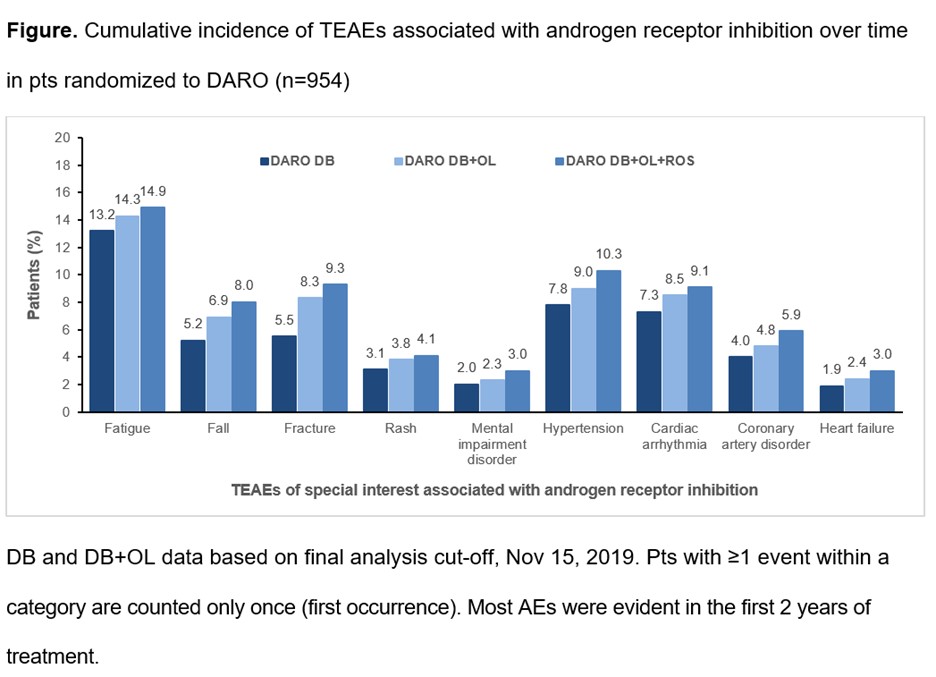Back
Introduction: In patients (pts) with nmCRPC, darolutamide (DARO) significantly improved metastasis-free survival by ~2 years and reduced the risk of death by 31% vs placebo, with a favorable safety profile (ARAMIS study; NCT02200614). We report the long-term safety and tolerability of DARO in the ARAMIS Rollover Study (ROS; NCT04464226).
Methods: In ARAMIS, 954 pts received double-blind (DB) DARO 600 mg orally twice daily, of whom 591 pts continued on open-label (OL) DARO following the primary analysis. On completion of ARAMIS, 294 pts with no evidence of metastases and benefitting clinically from DARO entered the ROS. DARO treatment duration and safety are described for the 954 pts over the DB, DB+OL, and DB+OL+ROS periods.
Results: At data cut-off of Jan 31, 2022, the median (range) duration of DARO treatment was DB 1.5 years (0.0–4.0), DB+OL 2.1 years (0.0–4.9), and DB+OL+ROS 2.8 years (0.0–6.8). Of the 954 randomized pts, 32.3% received DARO treatment for =2– <4 years, 17.3% for =4– <5 years, and 12.8% for =5 years. As expected, cumulative incidences of treatment-emergent adverse events (TEAEs) increased slightly with longer observation time. For the DB, DB+OL, and DB+OL+ROS periods, respectively, TEAE incidences were: any grade 85.7%, 89.8%, 91.5%; grade 3/4 26.3%, 31.8%, 35.5%; serious 26.1%, 32.1%, 38.5%; and leading to treatment discontinuation 8.9%, 10.5%, 12.9%. Increases in incidences of TEAEs commonly associated with androgen receptor inhibition across the DB, DB+OL, and DB+OL+ROS periods were mostly minimal (Fig). During the first 24 months of DARO treatment, incidences of most of these TEAEs were low and =2% different vs placebo, except for fatigue. Onset of these TEAEs by time intervals across all study phases (DB, DB+OL, DB+OL+ROS) will be presented.
Conclusions: Approximately 30% of pts with nmCRPC remained on DARO for =4 years, suggesting long-term clinical benefit. Most adverse events (AEs) occurred in the first 2 years of treatment, with small increments over time. The favorable safety profile of DARO was maintained with long-term exposure. No new safety concerns were observed in the ROS. SOURCE OF
Funding: Bayer AG and Orion Pharma.

Moderated Poster Session
Session: MP11: Prostate Cancer: Advanced (including Drug Therapy) I
MP11-14: Treatment duration and long-term safety and tolerability with darolutamide in nonmetastatic castration-resistant prostate cancer (nmCRPC): ARAMIS Rollover Study
Friday, April 28, 2023
9:30 AM – 11:30 AM CST
Location: S504
Poster Presenter(s)
Introduction: In patients (pts) with nmCRPC, darolutamide (DARO) significantly improved metastasis-free survival by ~2 years and reduced the risk of death by 31% vs placebo, with a favorable safety profile (ARAMIS study; NCT02200614). We report the long-term safety and tolerability of DARO in the ARAMIS Rollover Study (ROS; NCT04464226).
Methods: In ARAMIS, 954 pts received double-blind (DB) DARO 600 mg orally twice daily, of whom 591 pts continued on open-label (OL) DARO following the primary analysis. On completion of ARAMIS, 294 pts with no evidence of metastases and benefitting clinically from DARO entered the ROS. DARO treatment duration and safety are described for the 954 pts over the DB, DB+OL, and DB+OL+ROS periods.
Results: At data cut-off of Jan 31, 2022, the median (range) duration of DARO treatment was DB 1.5 years (0.0–4.0), DB+OL 2.1 years (0.0–4.9), and DB+OL+ROS 2.8 years (0.0–6.8). Of the 954 randomized pts, 32.3% received DARO treatment for =2– <4 years, 17.3% for =4– <5 years, and 12.8% for =5 years. As expected, cumulative incidences of treatment-emergent adverse events (TEAEs) increased slightly with longer observation time. For the DB, DB+OL, and DB+OL+ROS periods, respectively, TEAE incidences were: any grade 85.7%, 89.8%, 91.5%; grade 3/4 26.3%, 31.8%, 35.5%; serious 26.1%, 32.1%, 38.5%; and leading to treatment discontinuation 8.9%, 10.5%, 12.9%. Increases in incidences of TEAEs commonly associated with androgen receptor inhibition across the DB, DB+OL, and DB+OL+ROS periods were mostly minimal (Fig). During the first 24 months of DARO treatment, incidences of most of these TEAEs were low and =2% different vs placebo, except for fatigue. Onset of these TEAEs by time intervals across all study phases (DB, DB+OL, DB+OL+ROS) will be presented.
Conclusions: Approximately 30% of pts with nmCRPC remained on DARO for =4 years, suggesting long-term clinical benefit. Most adverse events (AEs) occurred in the first 2 years of treatment, with small increments over time. The favorable safety profile of DARO was maintained with long-term exposure. No new safety concerns were observed in the ROS. SOURCE OF
Funding: Bayer AG and Orion Pharma.


